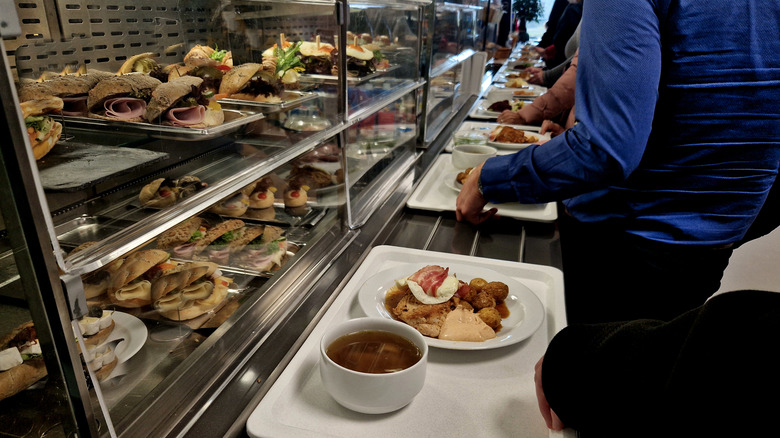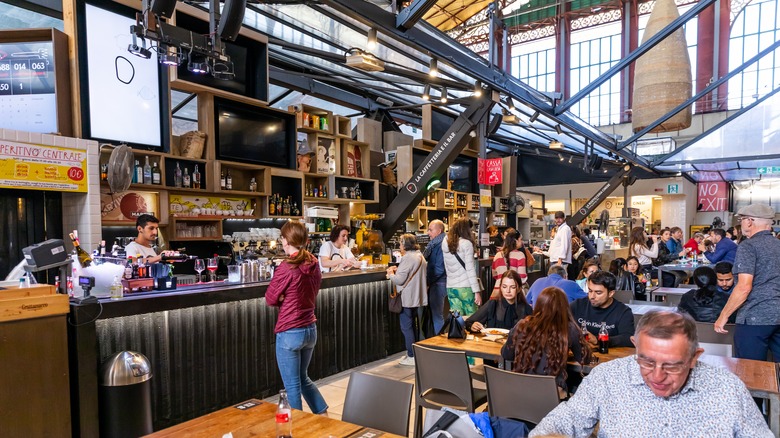A Type Of Eatery With Rooftop Views Is One Of The Cheapest Places To Eat In Europe, Per Rick Steves
Planning a European vacation can be an exciting, if research-intensive, process. From deciding whether to use open-jaw airline tickets, to whether or not to pack your toiletries with you, there can be a lot of decisions to work through before you get to the fun part of exploring a new place. While a large part of many people's European wish list includes trying the unique flavors and delicacies of their destination of choice, ultimately food choices can be not only confusing but also expensive. A travel budget can quickly fly out of the window when indulging in the unique foods and treats available — although some delicacies might be worth the splurge. Plus, as much as you might want to plan ahead, there is a certain level of spontaneity that should be kept during a vacation.
Luckily, European travel expert Rick Steves has done a lot of this kind of travel research already, and offers up a great deal of tips for travelers -– especially those who might feel overwhelmed by their choices –- on his travel site. With that said, if you find yourself struggling with your budget after overindulging during the first half of your trip, or you simply don't have much budget to work with during the duration of your trip, you might want to consider one of Steves' best bits of advice for finding cheap eats in Europe: a cafeteria. As Steves explains, "If your wallet is as empty as your stomach, find a cheap, humble cafeteria that's associated with (and subsidized by) a local institution — such as a university, church, hospital, charity, senior center, fire station, union of gondoliers, retired fishermen's club, and so on."
Taking advantage of cafeterias and institution eateries
Steves explains how tourists can take advantage of cafeteria style eating, "All over Europe, towering department stores offer great cafeteria lunches — often with rooftop views for no extra charge (such as at the Galeria Kaufhof in Frankfurt). These places are designed for the shopper who has a sharp eye for a good value. At a salad bar, grab the small (cheap) plate and stack it like the locals do — high. Hungry sightseers also appreciate the handy, moderately priced cafeterias they'll find in larger museums." For those looking for more bang for their buck, and perhaps even an excuse to explore more out of the way places, this dining option can be a particularly fun choice.
However, it's worth noting that, much like in the U.S., the cafeteria food that you find might not always be the most exciting or adventurous food out there. However, the affordability and access to a more local-adjacent lifestyle can make it worth it. As Steves explains, "Don't be afraid to take advantage of these opportunities to fill yourself with a plate of dull but nourishing food for an unbeatable price in the company of locals." Steves also explains that those pursuing cafeteria-style eateries on university campuses could find themselves enjoying the unique opportunity to talk with locals who are also more-likely to speak English. "University cafeterias (generally closed during summer holidays) also offer a surefire way to meet educated, English-speaking young people with open and stimulating minds," he explained, before adding, "They're often eager to share their views on politics and economics, as well as their English, with a foreign friend."
Other food options to consider
If traveling during the summertime, or over certain holidays, when institutions like universities are more likely to be closed, you might find your access to eateries like cafeterias more limited. With that said, there are a bevy of other cheap food options that you should also consider when looking for cheap eats in your European destination. For starters, the travel staple –- street food -– can offer cheap meal options on-the-go for travelers hoping to stay on a budget. From creperies to sausage stands to pizza, street food can offer travelers a chance to still experience the unique cuisine of the country they are visiting, without the attached large price tag for the experience. Similarly, Steves states that, "Bakeries are a good place to pick up basic sandwiches, tiny pizzas, or something equally cheap and fast but with more of a regional flavor (such as savory pasties in England or a croque monsieur sandwich in France)."
Another option, one that is growing in popularity in the U.S. as well, is the idea of a market or food hall. These dense market areas are generally filled with stalls offering everything from freshly caught seafood and groceries to specialty food items. As Steves explains, "These market halls still come with the farmers market dimension, but they've been spiced up with great eateries, priced for local shoppers and serving the freshest ingredients." It can be hard to determine which stall or food to try, especially in these crowded areas so Steves recommends keeping an eye on the locals, "At any stall where you see locals lining up, you know something exciting is being served."


